Business Process Management and Digital Innovations: A Systematic Literature Review
Abstract
1. Introduction
RQ. What are (un)covered aspects in the literature (state-of-art) of digital innovations for transforming business process management?
2. Research Background
2.1. Business Process Management (BPM)
2.2. Digital Innovation (DI)
2.3. Digital Innovation Trends in BPM
- (1)
- Ever changing customer experience
- (2)
- Stronger strategic link between BPM and digital innovation
- (3)
- Faster innovations, process changes, way of working
- (4)
- Increasing need for business-IT alignment
- (5)
- New CxO role to bring BPM and DI to the Board
- (6)
- BPM becomes more appealing (e.g., process modeling and monitoring)
- (7)
- Less resistance to BPM and digital innovation
2.3.1. BPM-DI Trend 1: Ever Changing Customer Experience
2.3.2. BPM-DI Trend 2: Stronger Strategic Link between BPM and Digital Innovation
2.3.3. BPM-DI Trend 3: Faster Innovations, Process Changes and Way of Working
2.3.4. BPM-DI Trend 4: Increasing Need for Business-IT Alignment
2.3.5. BPM-DI Trend 5: New CxO Role to Bring BPM and DI to the Board
2.3.6. BPM-DI Trend 6: BPM Becomes More Appealing (e.g., In Process Modeling and Monitoring)
2.3.7. BPM-DI Trend 7: Less Resistance to BPM and Digital Innovation
3. Methodology
3.1. SLR Protocol
3.2. Sources of Search
3.3. Search Criteria
3.4. Search Methods
3.5. Inclusion and Exclusion Criteria
3.6. Classification Scheme
4. Results
4.1. Chronological Distribution of the Sampled Papers
4.2. Geographical Distribution of the Sampled Papers
4.3. Mapping against BPM-DI Trends
4.4. Existing Research on the IS-Related Aspects of BPM
4.4.1. Mapping of Paper ID’s for IS-BPM Papers
4.4.2. Mapping of Relevant Themes for IS-Related BPM Papers
4.5. Existing Research on the Managerial Aspects of BPM
4.5.1. Mapping of Paper ID’s for Managerial BPM Papers
4.5.2. Mapping of Relevant Themes for Managerial BPM Papers
5. Discussion
5.1. IS-Related Research Agenda to Let BPM Advance in a Digital Economy
5.2. Management-Related Research Agenda to Let BPM Advance in a Digital Economy
5.3. Future Recommendations for BPM Practitioners
5.4. Research Limitations
6. Conclusions
Author Contributions
Funding
Acknowledgments
Conflicts of Interest
Appendix A. IS Research Themes
| Trend | IS-Related BPM Studies with a Digital Innovation Focus |
|---|---|
| 1 |
|
| 2 |
|
| 3 |
|
| 4 |
|
| 5 |
|
| 6 |
|
| 7 |
|
Appendix B. Managerial Research Themes
| Trend | Managerial BPM Studies with a Digital Innovation Focus |
|---|---|
| 1 |
|
| 2 |
|
| 3 |
|
| 4 |
|
| 5 |
|
| 6 |
|
| 7 |
|
Appendix C. IS Research Agenda
| (C1) BPM-DI Trend | (C2) Initial Research Avenues by [12] | (C3) Key Variables in Our SLR | (C4) Demonstrated Research Avenues (More Research on…) |
|---|---|---|---|
| Trend 1 | Methods and techniques for intelligent/collaboration/case-driven BPM to proactively meet changing customer needs |
|
|
| How to use customer data (e.g., expectations, performance perceptions, satisfaction) in diagnostic/predictive/prescriptive process analytics |
| ||
| Trend 2 | Explorative methods and techniques (ambidextrous BPM) |
|
|
| The strategic use of new IT to improve process efficiency and effectiveness |
| ||
| Trend 3 | Methods and techniques for faster BPM cycles |
|
|
| Applying agile principles to BPM (agile BPM) |
| ||
| Trend 4 | How to integrate the process architecture into the overall enterprise architecture with application and technical architectures that embrace new IT |
|
|
| Collaboration platforms per process lifecycle stage |
| ||
| Trend 5 | New CEO role to bring BPM DI to the board |
|
|
| Trend 6 | Process modeling alternatives (e.g., journey mapping via comic books and video apps) |
|
|
| How process monitoring tools can become more approachable for a wider (non-expert) audience (e.g., dashboards and tableaux techniques) |
| ||
| Tools supporting case-driven BPM and knowledge-intensive/unstructured processes |
| ||
| Monitoring tools for intelligent BPM |
| ||
| Trend 7 | How to use employee data (e.g., job satisfaction, perceived work difficulty, stress) in diagnostic/predictive/prescriptive process analytics |
|
|
| User-friendly artifacts (e.g., evaluation criteria) to be accessible to non-experts |
|
Appendix D. Managerial Research Agenda
| (C1) BPM-DI Trend | (C2) Initial Research Avenues by [12] | (C3) Key Aariables in our SLR | (C4) Demonstrated Research Avenues (More Research on…) |
|---|---|---|---|
| Trend 1 | Co-creation of process value with end customers |
|
|
| The realization of process-oriented values like customer understanding and experience (Customer Process Management) |
| ||
| Trend 2 | BPM critical success factors from a DI perspective |
|
|
| Strategic alignment between BPM and DI (value-driven BPM) |
| ||
| Disruptive business models and the impact on BPM |
| ||
| Guidelines for balancing an exploitative and explorative approach (ambidextrous BPM) |
| ||
| Trend 3 | Studying and improving the process of DI |
|
|
| Time management and project management for process owners |
| ||
| Maturity models facilitating a BPM-DI adoption |
| ||
| Trend 4 | The degree to which traditional business-IT alignment models apply to a DI context |
|
|
| Trend 5 | BPM governance, and the sometimes conflicting roles of Chief Operations/Process managers, Chief Information managers and Chief Innovation managers |
|
|
| Trend 6 | Best practices and success stories to share knowledge and find BPM-DI advocates |
|
|
| Trend 7 | How change management models and techniques offer best practices for BPM |
|
|
| New curricula in IT and BPM |
| ||
| How management and innovation can be taught to kids as from primary school |
|
Appendix E. SLR Sample
References
- Singh, S.K.; Rathore, S.; Park, J.H. BlockIoTIntelligence: A Blockchain-enabled Intelligent IoT Architecture with Artificial Intelligence. Future Gener. Comput. Syst. 2019, 110, 721–743. [Google Scholar] [CrossRef]
- Ferraris, A.; Monge, F.; Mueller, J. Ambidextrous IT capabilities and business process performance: An empirical analysis. Bus. Process Manag. J. 2018, 24, 1091–1109. [Google Scholar] [CrossRef]
- Rosemann, M. Proposals for future BPM research directions. In Asia-Pacific Business Process Management; Springer: Cham, Switzerland, 2014; Volume 181, pp. 1–15. [Google Scholar]
- Dumas, M.; La Rosa, M.; Mendling, J.; Reijers, H.A. Introduction to Business Process Management. In Fundamentals of Business Process Management; Springer: Berlin, Germany, 2013; ISBN 9783642331428. [Google Scholar]
- Tarhan, A.; Turetken, O.; Reijers, H.A. Business process maturity models: A systematic literature review. Inf. Softw. Technol. 2016, 75, 122–134. [Google Scholar] [CrossRef]
- Rosemann, M.; Brocke, J. The Six Core Elements of Business Process Management; Springer: Berlin/Heidelberg, Germany, 2015; ISBN 978-3-642-00415-5. [Google Scholar]
- Vom Brocke, J.; Zelt, S.; Schmiedel, T. On the role of context in business process management. Int. J. Inf. Manag. 2015, 36, 486–495. [Google Scholar] [CrossRef]
- Ahmad, T.; Looy, A. Van Reviewing the historical link between Business Process Management and IT: Making the case towards digital innovation. In Proceedings of the IEEE Thirteen International Conference on Research Challenges in Information Science, Brussels, Belgium, 29–31 May 2019; pp. 75–86. [Google Scholar]
- Mendling, J.; Pentland, B.; Recker, J. Building a Complementary Agenda for Business Process Management and Digital Innovation. Eur. J. Inf. Syst. 2020, 29. [Google Scholar] [CrossRef]
- Beverungen, D.; Buijs, J.C.A.M.; Becker, J.; Di Ciccio, C.; van der Aalst, W.M.P.; Bartelheimer, C.; vom Brocke, J.; Comuzzi, M.; Kraume, K.; Leopold, H.; et al. Seven Paradoxes of Business Process Management in a Hyper-Connected World. Bus. Inf. Syst. Eng. 2020. [Google Scholar] [CrossRef]
- Yun, J.H.J.; Jung, W.Y.; Yang, J.H. Knowledge strategy and business model conditions for sustainable growth of SMEs. J. Sci. Technol. Policy Manag. 2015, 6, 246–262. [Google Scholar] [CrossRef]
- Van Looy, A.; Poels, G. A Practitioners’ Point of View on How Digital Innovation Will Shape the Future of Business Process Management: Towards a Research Agenda. In Proceedings of the 52nd Hawaii International Conference on System Sciences, Grand Wailea, HI, USA, 8–11 January 2019; Volume 6, pp. 6448–6457. [Google Scholar]
- Nunamaker, J.F.; Briggs, R.O.; Derrick, D.C.; Schwabe, G. The Last Research Mile: Achieving Both Rigor and Relevance in Information Systems Research. J. Manag. Inf. Syst. 2015, 32, 10–47. [Google Scholar] [CrossRef]
- Paschek, D.; Luminosu, C.T.; Draghici, A. Automated business process management—In times of digital transformation using machine learning or artificial intelligence. MATEC Web Conf. 2017, 121, 04007. [Google Scholar] [CrossRef]
- Marrella, A. What Automated Planning Can Do for Business Process Management. In Business Process Management Workshops; Springer: Barcelona, Spain, 2017; pp. 7–19. [Google Scholar]
- Koopman, A.; Seymour, L.F. Factors impacting successful BPMS adoption and use: A South African financial services case study. In Enterprise, Business-Process and Information Systems Modeling; Springer: Cham, Switzerland, 2020; Volume 387, pp. 55–69. [Google Scholar]
- Binci, D.; Belisari, S.; Appolloni, A. BPM and change management: An ambidextrous perspective. Bus. Process Manag. J. 2019, 26, 1–23. [Google Scholar] [CrossRef]
- Klun, M.; Trkman, P. Business process management—At the crossroads. Bus. Process Manag. J. 2018, 24, 786–813. [Google Scholar] [CrossRef]
- Guadalupe, M.; Li, H.; Wulf, J.; Brynjolfsson, E.; Collis, D.; Dessein, W.; Gibbons, B.; Greenstein, S.; Hambrick, D.; Helfat, C.; et al. Who Lives in the C-Suite? Organizational Structure and the Division of Labor in Top Management. Manag. Decis. 2014, 60, 824–844. [Google Scholar] [CrossRef]
- Fichman, R.G.; Dos Santos, B.L.; Zheng, Z. Digital Innovation as a Fundamental and Powerful Concept in the Information Systems Curriculum. MIS Q. 2014, 38, 329–343. [Google Scholar] [CrossRef]
- van der Aalst, W.M.P.; Netjes, M.; Reijers, H.A. Supporting the Full BPM Life-Cycle Using Process Mining and Intelligent Redesign. In Contemporary Issues in Database Design and Information Systems Development; IGI Global: Pennsylvania, PA, USA, 2007; pp. 100–132. ISBN 9781599042893. [Google Scholar]
- Demirkan, H.; Spohrer, J. Developing a framework to improve virtual shopping in digital malls with intelligent self-service systems. J. Retail. Consum. Serv. 2014, 21, 860–868. [Google Scholar] [CrossRef]
- Gomes, J.; Portela, F.; Santos, M.F. Introduction to BPM approach in Healthcare and Case Study of End User Interaction with EHR Interface. Procedia Comput. Sci. 2018, 141, 519–524. [Google Scholar] [CrossRef]
- Gebhart, M.; Mevius, M.; Wiedmann, P. Application of Business Process Quality Models in Agile Business Process Management. In Proceedings of the Sixth International Conference on Information, Process, and Knowledge Management eKNOW, Barcelona, Spain, 23–27 March 2014; pp. 152–158. [Google Scholar]
- Houy, C.; Fettke, P.; Loos, P. Empirical research in business process management—analysis of an emerging field of research. Bus. Process Manag. J. 2010, 16, 619–661. [Google Scholar] [CrossRef]
- Choi, H. Technology-push and demand-pull factors in emerging sectors: Evidence from the electric vehicle market. Ind. Innov. 2018, 25, 655–674. [Google Scholar] [CrossRef]
- Spiess, J.; T’Joens, Y.; Dragnea, R.; Spencer, P.; Philippart, L. Using big data to improve customer experience and business performance. Bell Labs Tech. J. 2014, 18, 3–17. [Google Scholar] [CrossRef]
- Barnes, C.; Blake, H.; Pinder, D. Creating and Delivering Your Value Proposition: Managing Customer Experience for Profit; Kogan Page: London, UK, 2009; ISBN 0749458593. [Google Scholar]
- Bleier, A.; de Keyser, A.; Verleye, K. Customer engagement through personalization and customization. In Customer Engagement Marketing; Macmillan, P., Ed.; Springer International Publishing: Cham, Switzerland, 2018; pp. 75–94. ISBN 9783319619859. [Google Scholar]
- pmanagement: A literature review and classification. Expert Syst. Appl. 2009, 36, 2592–2602. [CrossRef]
- Monkaresi, H.; Calvo, R.A.; Yan, H. A Machine Learning Approach to Improve Contactless Heart Rate Monitoring Using a Webcam. IEEE J. Biomed. Health Inform. 2014, 18, 1153–1160. [Google Scholar] [CrossRef]
- Steve, B.; Rich, G.; Eonju, L.; Joseph, M.; Brian, N.; Andreas, S.; Zac Sprackett, S. Automated Customer Interest Processing in a Customer Relationship Management (crm) Application. US Patent 20200118220A1, 16 April 2020. [Google Scholar]
- Heckmann, C.S.; Maedche, A. IT ambidexterity for business processes: The importance of balance. Bus. Process Manag. J. 2018, 24, 862–881. [Google Scholar] [CrossRef]
- Lubatkin, M.H.; Simsek, Z.; Ling, Y.; Veiga, J.F. Ambidexterity and Performance in Small-to Medium-Sized Firms: The Pivotal Role of Top Management Team Behavioral Integration. J. Manag. 2006, 32, 646–672. [Google Scholar] [CrossRef]
- Lee Kuo Chuen, D. Handbook of Digital Currency: Bitcoin, Innovation, Financial Instruments, and Big Data; Elsevier Science: Amsterdam, The Netherlands, 2015; ISBN 9780128023518. [Google Scholar]
- Zamuria, D.R.; Molina, E.S. The experience of agile business process management implementation. In Proceedings of the 2017 IEEE 37th Central America and Panama Convention, CONCAPAN, Managua, Nicaragua, 15–17 November 2017. [Google Scholar] [CrossRef]
- Von Rosing, M.; von Scheel, H.; Scheer, A.-W. The Complete Business Process Handbook: Body of Knowledge from Process Modeling to BPM; Elsevier Science: Amsterdam, The Netherlands, 2014. [Google Scholar]
- Chountalas, P.T.; Lagodimos, A.G. Paradigms in business process management specifications: A critical overview. Bus. Process Manag. J. 2018, 25, 1040–1069. [Google Scholar] [CrossRef]
- Jalali, A. Teaching Business Process Development Through Experience-Based Learning and Agile Principle. In Perspectives in Business Informatics Research; BIR 2018; Springer Nature: Cham, Swizerland, 2018; Volume 330, pp. 250–265. [Google Scholar]
- Lückmann, P.; Feldmann, C. Success Factors for Business Process Improvement Projects in Small and Medium Sized Enterprises—Empirical Evidence. Procedia Comput. Sci. 2017, 121, 439–445. [Google Scholar] [CrossRef]
- Rosemann, M.; de Bruin, T. Towards a business process management maturity model. In Proceedings of the 13th European Conference on Information Systems (ECIS 2005), Regensburg, Germany, 26–28 May 2005; The London School of Economics: London, UK, 2005; pp. 521–532. [Google Scholar]
- Eppinger, S.D. Innovation at the Speed of Information. Harv. Bus. Rev. 2001, 79, 149–158. [Google Scholar] [PubMed]
- Davis, F.D.; Bagozzi, R.P.; Warshaw, P.R. User Acceptance of Computer Technology: A Comparison of Two Theoretical Models. Manag. Sci. 1989, 35, 982–1003. [Google Scholar] [CrossRef]
- Fielt, E.; Westerveld, P.; Desouza, K.C.; Gable, G.G. Business model innovation and strategic transformation when confronting digital disruption: The case of data-driven business models for professional services. In Proceedings of the 29th Australasian Conference on Information Systems (ACIS 2018), Sydney, Australia, 3–5 December 2018. [Google Scholar]
- Venkatraman, N.; Henderson, J.C.; Oldach, S. Continuous strategic alignment: Exploiting information technology capabilities for competitive success. Eur. Manag. J. 1993, 11, 139–149. [Google Scholar] [CrossRef]
- Rahimi, F.; Møller, C.; Hvam, L. Business process management and IT management: The missing integration. Int. J. Inf. Manag. 2016, 36, 142–154. [Google Scholar] [CrossRef]
- Wong, C.; Skipworth, H.; Godsell, J.; Achimugu, N. Towards a theory of supply chain alignment enablers: A systematic literature review. Supply Chain Manag. 2012, 17, 419–437. [Google Scholar] [CrossRef]
- Malinova, M.; Mendling, J. Identifying do’s and don’ts using the integrated business process management framework. Bus. Process Manag. J. 2018, 24, 882–899. [Google Scholar] [CrossRef]
- Tecwyn Hill The Importance of Business & IT Alignment | Signavio. Available online: https://www.signavio.com/post/importance-of-business-and-it-alignment/ (accessed on 1 July 2019).
- Jarvenpaa, S.L.; Ives, B. Executive Involvement and Participation in the Management of Information Technology. MIS Q. 1991, 15, 205. [Google Scholar] [CrossRef]
- Rockart, J.F.; DeLong, D.W. Executive Support System: The Emergence of Top Management Computer Use; Dow Jones-Irwin: New York, NY, USA, 1988; ISBN 0870949551. [Google Scholar]
- Kashefi, A.; Abbott, P.; Daniel Ayoung, A. User IT Adaptation Behaviors: What Have We Learned and Why Does it Matter? In Proceedings of the 21st Americas Conference on Information Systems, Fajardo, Puerto Rico, 13–15 August 2015. [Google Scholar]
- Pavlou, P.A. Consumer acceptance of electronic commerce: Integrating trust and risk with the technology acceptance model. Int. J. Electron. Commer. 2003, 7, 101–134. [Google Scholar] [CrossRef]
- Denner, M.-S.; Püschel, L.C.; Röglinger, M. How to Exploit the Digitalization Potential of Business Processes. Bus. Inf. Syst. Eng. 2017, 60, 331–349. [Google Scholar] [CrossRef]
- Veale, T.; Feyaerts, K.; Forceville, C. Creativity and the Agile Mind: A Multi-Disciplinary Study of a Multi-Faceted Phenomenon; Walter de Gruyter: Berlin, Germany, 2013. [Google Scholar]
- Von Rosing, M.; Von Scheel, J.; Gill, A.Q. Applying Agile Principles to BPM; Elsevier: Amsterdam, The Netherlands, 2014; Volume 1, ISBN 9780128004722. [Google Scholar]
- Alekseev, A.; Korchuganova, T.; Padolski, S. The BigPanDA self-monitoring alarm system for ATLAS. In Proceedings of the Distributed Computing and Grid-technologies in Science and Education, Dubna, Russia, 3 December 2018. [Google Scholar]
- Klievink, B.; Janssen, M. Barriers and impediments to transformational government: Insights from literature and practice. Artic. Electron. Gov. Int. J. 2011, 8, 226–241. [Google Scholar] [CrossRef]
- Abbas, A.K.; Leonhardt, S. Intelligent neonatal monitoring based on a virtual thermal sensor. BMC Med. Imaging 2014, 14, 9. [Google Scholar] [CrossRef] [PubMed]
- Richards, G.; Yeoh, W.; Chong, A.Y.L.; Popovič, A. Business Intelligence Effectiveness and Corporate Performance Management: An Empirical Analysis. J. Comput. Inf. Syst. 2019, 59, 188–196. [Google Scholar] [CrossRef]
- Paschek, D.; Ivascu, L.; Draghici, A. Knowledge Management—The Foundation for a Successful Business Process Management. Procedia Soc. Behav. Sci. 2018, 238, 182–191. [Google Scholar] [CrossRef]
- Hoesch-Klohe, K.; Ghose, A.; Lê, L.-S. Towards Green Business Process Management. In Proceedings of the 2010 IEEE International Conference on Services Computing, Piscataway, NJ, USA, 5–10 July 2010; pp. 386–393. [Google Scholar]
- Mendling, J.; Decker, G.; Hull, R.; Reijers, H.A.; Weber, I. How do Machine Learning, Robotic Process Automation, and Blockchains Affect the Human Factor in Business Process Management? Commun. Assoc. Inf. Syst. 2018, 297–320. [Google Scholar] [CrossRef]
- Karnouskos, S. Effective Change Management in Modern Enterprises. Master’s Thesis, Linnaeus University, Växjö, Sweden, 2015. [Google Scholar]
- Schmiedel, T.; vom Brocke, J. Business Process Management: Potentials and Challenges of Driving Innovation. In Driving Innovation in a Digital World. Management for Professionals; Springer: Cham, Switzerland, 2015; pp. 3–15. [Google Scholar]
- Dixon, N.M. The Organizational Learning Cycle; Gower Publishing Limited: Vermont, VT, USA, 2017; ISBN 9781315554945. [Google Scholar]
- Hribar, B.; Mendling, J. The Correlation of Organizational Culture and Success of BPM Adoption. In Proceedings of the European Conference on Information Systems (ECIS) 2014, Tel Aviv, Israel, 9–11 June 2014. [Google Scholar]
- Kitchenham, B. Procedures for Performing Systematic Reviews; Keele University: Keele, UK, 2004; Volume 33, pp. 1–26. [Google Scholar]
- Brereton, P.; Kitchenham, B.A.; Budgen, D.; Turner, M.; Khalil, M. Lessons from applying the systematic literature review process within the software engineering domain. J. Syst. Softw. 2007, 80, 571–583. [Google Scholar] [CrossRef]
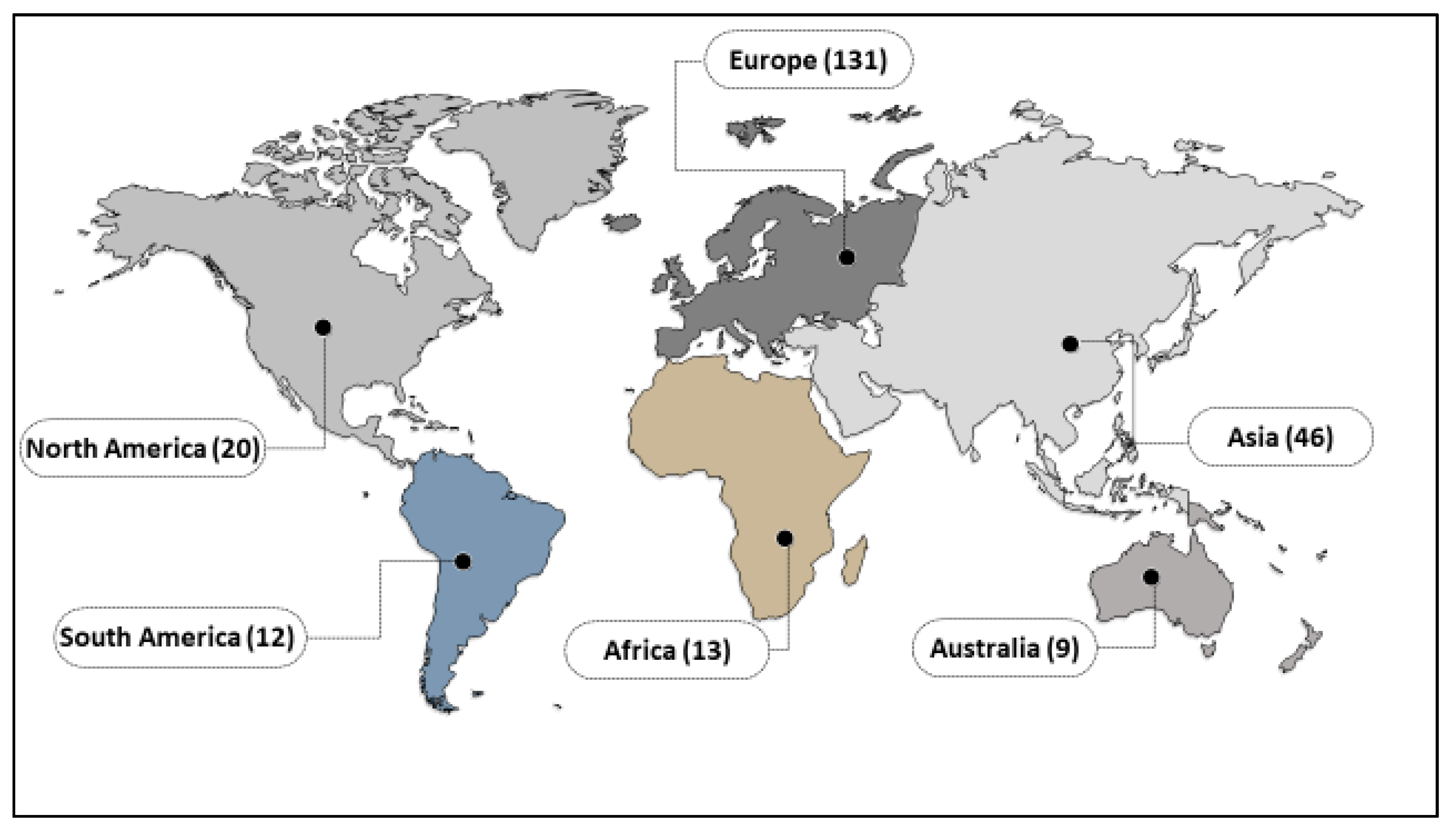
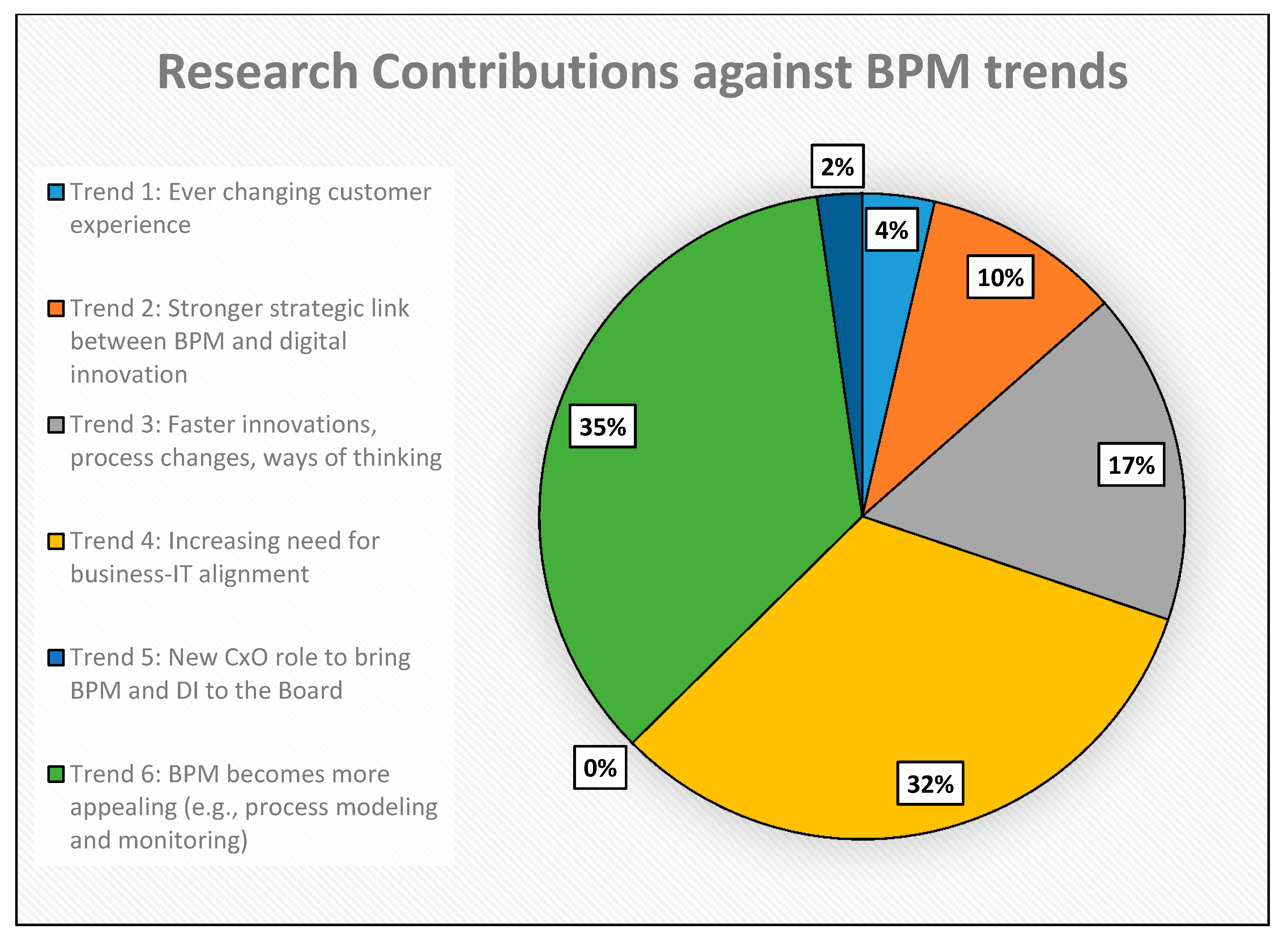
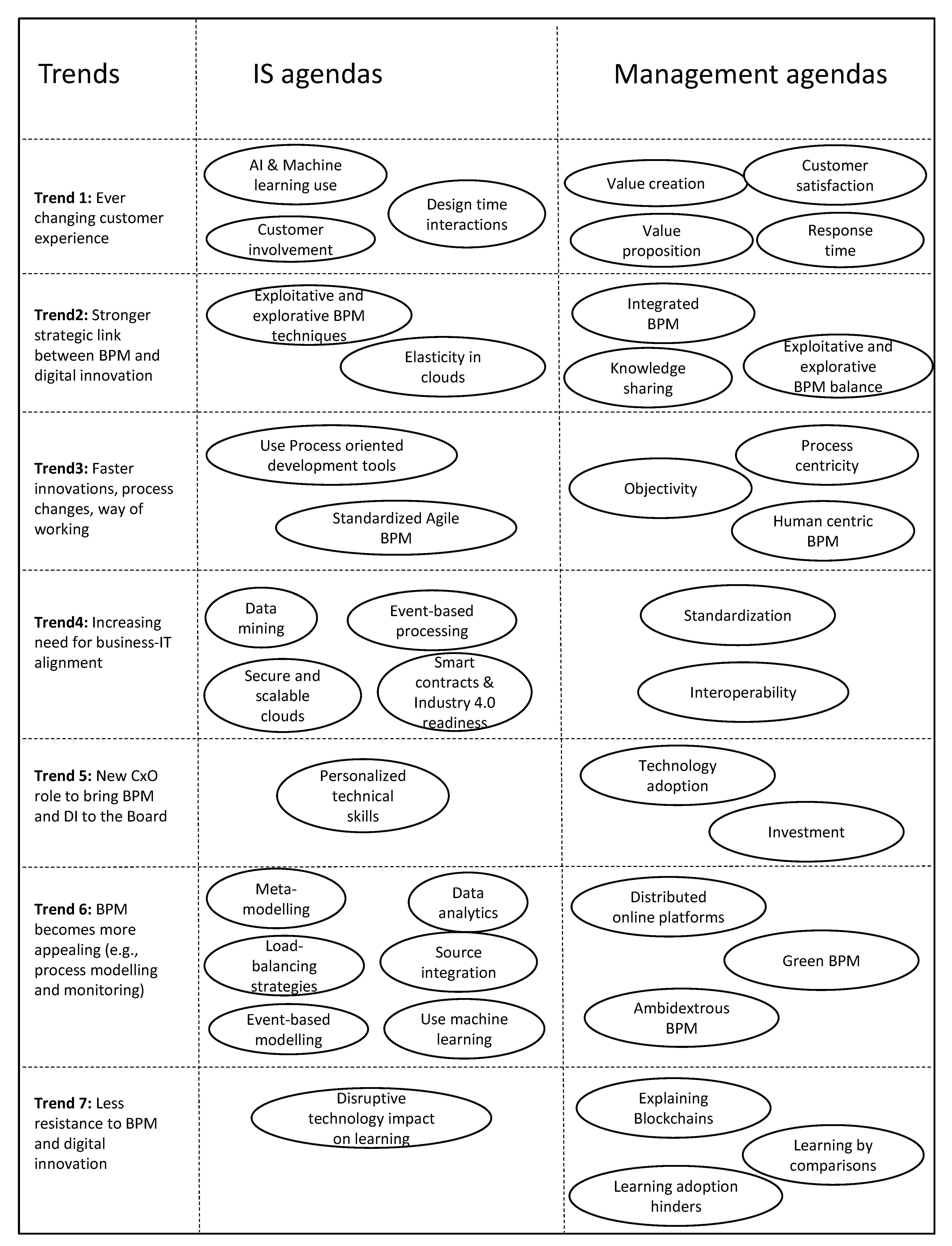
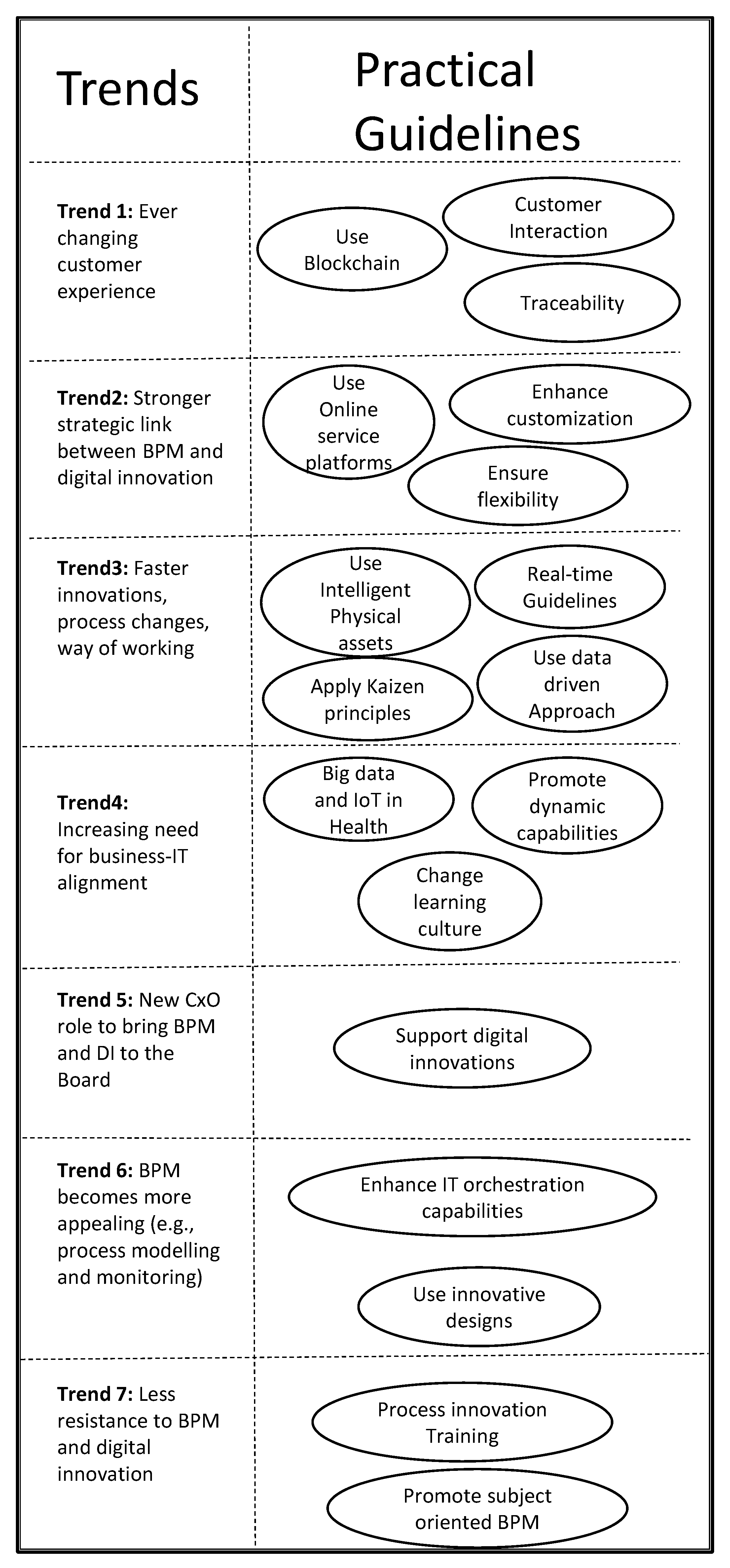
| Sources of Search | Web of science; Ebscohost; Scopus; Science Direct; Jstor |
| Search terms used | A combination of: “Business Process Management” with new information technology paradigms, approaches or solutions (See Table 2) |
| Search strategy | All search requests were done with keywords in “Topic” (See Table 3) |
| Inclusion criteria | All relevant book chapters, journal articles and conference proceedings that were written in English were retrieved after applying the predefined search terms and strategy |
| Exclusion criteria | Duplicates and Irrelevant studies (i.e., that do not fit into BPM and new IT or digital innovations) were excluded Only recent studies from the last five years (i.e., published in 2014 or later, until May 2019) to focus on emerging technologies only |
| Quality criteria | Only peer-reviewed articles |
| Keyword (1) | Operator | Keyword(s) (2) |
|---|---|---|
| “Business Process Management” | AND | “Agile” or “Agility” |
| “Blockchain” or “Blockchains” | ||
| “Ambidexterity” or “Ambidextrous” | ||
| “Artificial Intelligence” or “Business Intelligence” | ||
| “Digital Innovation” or “Digital Transformation” | ||
| “Cloud computing” or “Cloud” | ||
| “Industry 4.0” |
| Databases | WoS | Ebsco-Host | Scopus | Science Direct | Jstor | Total | |
|---|---|---|---|---|---|---|---|
| Keywords | |||||||
| “Business Process Management” | “Agile” OR “Agility” | 35 | 27 | 60 | 190 | 2 | 314 |
| “Business Process Management” | “Blockchain” OR “Blockchains” | 5 | 8 | 22 | 21 | 0 | 56 |
| “Business Process Management” | “Ambidexterity” OR “Ambidextrous” | 10 | 16 | 14 | 24 | 0 | 64 |
| “Business Process Management” | “Artificial Intelligence” OR “Business Intelligence” | 10 | 1 | 57 | 94 | 1 | 163 |
| “Business Process Management” | “Digital Innovation” OR “Digital Transformation” | 1 | 1 | 6 | 5 | 0 | 13 |
| “Business Process Management” | “Cloud computing” OR “Cloud” | 62 | 48 | 99 | 213 | 1 | 423 |
| “Business Process Management” | “Industry 4.0” | 12 | 8 | 24 | 50 | 0 | 94 |
| “Business Process Management” | “Internet of Things” | 30 | 35 | 58 | 142 | 1 | 266 |
| Total | 135 | 109 | 282 | 597 | 4 | 1393 |
| Total Number of Papers Retrieved (Topic Wise Search) | 1393 | ||
|---|---|---|---|
| Removed Duplicates | −502 | ||
| Removed Non-applicable papers | −42 | ||
| Additional screening (Not found in Title vs. Topic search) | −618 | ||
| Total: (Final SLR sample) | 231 | ||
| Classification: | |||
| IS-related BPM papers | 135 | ||
| Managerial BPM papers | 87 | ||
| Existing literature reviews | 9 | ||
| Initial BPM-DI Trends (Expert Panel) | Paper Count | Paper IDs |
|---|---|---|
| 1/Ever changing customer experience | 4 | 95, 147, 155, 228 |
| 2/Stronger strategic link between BPM and digital innovation | 7 | 14, 27, 30, 35, 79, 98, 229 |
| 3/Faster innovations, process changes, way of working | 16 | 2, 7, 45, 85, 86, 88, 89, 105, 106, 120, 122, 178, 182, 189, 205, 207 |
| 4/Increasing need for business-IT alignment | 50 | 1, 4, 6, 12, 13, 50, 51, 62, 64, 65, 66, 67, 70, 71, 76, 81, 82, 84, 102, 103, 109, 110, 111, 119, 131, 133, 135, 136, 143 145, 151, 152, 161, 173, 185, 188, 190, 196, 200, 201, 202, 204, 208, 214, 215, 216, 217, 220, 227, 230 |
| 5/New CxO role to bring BPM and DI to the Board | 0 | No papers found |
| 6/BPM becomes more appealing (e.g., process modeling, monitoring) | 57 | 8, 9, 10, 11, 16, 26, 33, 49, 52, 54, 56,59, 60, 61, 63, 69, 78, 83, 91, 92, 104, 107, 112, 114, 116, 117, 123, 124, 129, 130, 132, 134, 137, 138, 139, 146, 149, 150, 156, 157, 159, 162, 163, 166, 168, 184, 186, 187, 192, 194, 199, 213, 218, 219, 221, 222, 225 |
| 7/Less resistance to BPM and digital innovation | 1 | 46 |
| Initial BPM-DI Trends (Expert Panel). | Paper Count | Paper IDs |
|---|---|---|
| 1/Ever changing customer experience | 4 | 31, 53, 87, 174 |
| 2/Stronger strategic link between BPM and digital innovation | 15 | 37, 38, 39, 40, 41, 42, 43, 44, 80 93, 96, 99, 176, 210, 211, |
| 3/Faster innovations, process changes, way of working | 21 | 3, 18, 19, 20, 23, 24, 25, 28, 32, 34, 36, 47, 121, 125, 126, 177, 180, 181,206, 22, 224 |
| 4/Increasing need for business-IT alignment | 22 | 15, 21, 29, 48, 55, 68, 73, 74, 77, 115, 141, 142, 144, 148, 170, 183, 193, 197, 198, 203, 223, 158 |
| 5/New CxO role to bring BPM and DI to the Board | 0 | No papers found |
| 6/BPM becomes more appealing (e.g., process modeling, monitoring) | 21 | 17, 57, 58, 75, 100, 108, 118, 128, 160, 163, 164, 165, 169, 171, 172, 175, 191,195, 212, 231 |
| 7/Less resistance to BPM and digital innovation | 4 | 94, 127, 140, 226 |
© 2020 by the authors. Licensee MDPI, Basel, Switzerland. This article is an open access article distributed under the terms and conditions of the Creative Commons Attribution (CC BY) license (http://creativecommons.org/licenses/by/4.0/).
Share and Cite
Ahmad, T.; Van Looy, A. Business Process Management and Digital Innovations: A Systematic Literature Review. Sustainability 2020, 12, 6827. https://doi.org/10.3390/su12176827
Ahmad T, Van Looy A. Business Process Management and Digital Innovations: A Systematic Literature Review. Sustainability. 2020; 12(17):6827. https://doi.org/10.3390/su12176827
Chicago/Turabian StyleAhmad, Tahir, and Amy Van Looy. 2020. "Business Process Management and Digital Innovations: A Systematic Literature Review" Sustainability 12, no. 17: 6827. https://doi.org/10.3390/su12176827
APA StyleAhmad, T., & Van Looy, A. (2020). Business Process Management and Digital Innovations: A Systematic Literature Review. Sustainability, 12(17), 6827. https://doi.org/10.3390/su12176827






